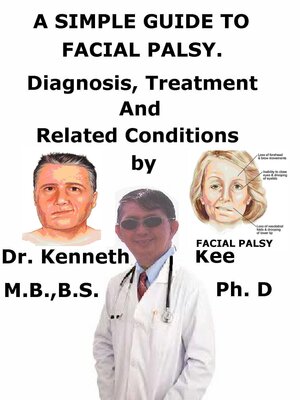
Sign up to save your library
With an OverDrive account, you can save your favorite libraries for at-a-glance information about availability. Find out more about OverDrive accounts.
Find this title in Libby, the library reading app by OverDrive.



Search for a digital library with this title
Title found at these libraries:
| Library Name | Distance |
|---|---|
| Loading... |
This book describes the Facial Palsy, Diagnosis and Treatment and Related Diseases
Facial Palsy is the pressure on the facial nerve causing paralysis
The cause is unknown but ranged from hereditary to sarcoidosis
The facial muscles on one side is weak and drooping
The eye cannot close properly and there is saliva dribbling
Bell's Palsy is the most common form of Facial palsy
Smiling usually show up the presence of facial paresis
There is no definitive test available for Bell's palsy
Physical signs and electromyogram determines the extent of the nerve paralysis
The face is crooked on one side with drooping of the lips
The eye on one side cannot close properly with out turned eyelids
There is blinking or tears in the eye while eating
There is dribbling of saliva and difficulty in talking
The treatment is to start urgently on a course of oral prednisolone
Physiotherapy of the facial muscles is used to restore the facial muscle tone.
The eyes need to be protected by wearing glasses or using eye ointment
Most patients will recover within 3 weeks of treatment
-An original poem by Kenneth Kee
Bell's facial palsy is the most frequent cause of facial paralysis.
While early medical trials of mRNA COVID-19 vaccines reported a very small number of post-vaccine Bell's facial palsy cases, later studies detected no relation between the two.
New treatment methods for facial palsy are Facial neuromuscular retraining, Botulinum toxin injection and surgery for post-paralytic syndrome.
Facial Palsy is the paralysis of the facial nerve (7th cranial nerve) from its origin in the brain right to the branches of the nerve in the face.
Bell palsy also termed idiopathic facial paralysis (IFP) is the most frequent cause of unilateral facial paralysis and the most frequent cause of facial paralysis worldwide.
When Facial Palsy happens, the function of the facial nerve is disrupted producing a disruption in the messages the brain transmits to the facial muscles.
This disruption leads to facial weakness or paralysis.
Facial Palsy involves only one of the paired facial nerves and one side of the face but rarely can affect both sides.
The cause of Facial palsy is unknown though the disease seems to be a polyneuritis with possible viral, inflammatory, autoimmune and ischemic causes.
The facial nerve becomes inflamed in reaction to the infection causing pressure within the Fallopian canal and leading to ischemia of the nerve cells.
The minimum diagnostic criteria for facial palsy are paralysis or paresis of all muscle groups on one side of the face, sudden onset and absence of CNS disease.
The most important part of the diagnosis is to distinguish between the supra-nuclear and infra-nuclear causes of facial palsy.
Supra-nuclear
The movements of the upper part of the face is not affected since the forehead muscles have bilateral cortical representations
Infra-nuclear
Weakness of facial muscle on 1 side, with drooping of the mouth on 1 side, sagging eyelids, difficulty in closing the eye.
Some Facial Palsy cases are mild and do not need treatment as the symptoms normally subside on their own within 2 weeks.
Treatment involves:
Corticosteroid therapy
Antiviral agents
Eye care: Topical ocular lubrication to prevent corneal drying, abrasion and ulcers
Physiotherapy
Surgical treatments are:
Facial nerve decompression
Subocularis oculi fat lift
Implantable devices in the eyelid
Tarsorrhaphy
Transposition of the temporalis muscle
Facial nerve grafting
TABLE OF...







